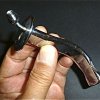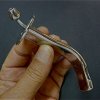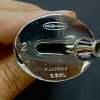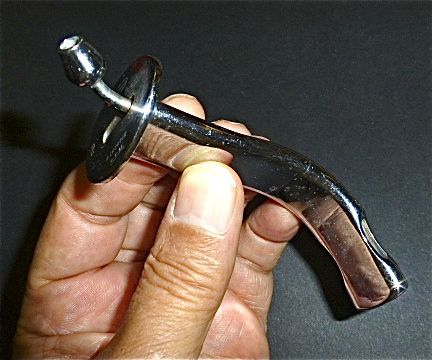Anästhesie |
||
Mundtubus n. Mona ROBERTS |
||
Der Mundtubus von Frau Doktor Mona ROBERTS wurde 1916 in die Anaesthesie eingeführt (Dr. K. Sudarshan, Consultant Anaesthetist Coimbatore, in: Advances in Supraglottic Airway). Er diente primär zur Aethernarkose, wie aus folgendem Zitat hervorgeht (Anaesthesia, 1981 Vol. 36 p. 479): "The Mona Roberts Airway was described as an oral tube for the administration of open ether anaesthesia. It is a flat, hollow, metal airway with a flange at the external end the upper edge of which is hollowed out to fit beneath the nostrils. The slit in the lower border of the flange was to permit a tape to be tied round the patients neck and then attached to the airway. The airway would pass easily once reflexes had been abolished by anaesthesia or, if light, then a mouth gag and tongue forceps facilitated its use’" (Roberts M.D. New inventions. An oral tube in open ether anaesthesia. Lancet 1916; II p. 1060). Wir müssen uns den Tubus also im Zusammenhang mit einer Maske vorstellen, auf die der/die Anaesthesist/in fleissig Aether tropft … Eine SauerstoffFlasche steht daneben parat für den Fall, dass der Patient wiederbelebt werden muss oder die Narkose ausgeleitet wird. Nota: gegen Erbrechen schützte der Tubus nicht, lediglich vor dem Rückwärtsfallen der Zunge. Der Tubus wurde von 1916-1946 hergestellt (Rod Calverley, A rare bit of Welsh History, in: Anesthesia History Association Newsletter Vol.11, Nr.4, Okt. 1993 p.2), erfreute sich also grosser Beliebtheit, auch wenn er heute vergessen ist.
Ein Roberts'tube (ohne Sauerstoffkanal) gehört zum Fundus des Australischen Museums und wurde in einer Psychiatrischen Anstalt von Victoria/Australien bei Narkosen benutzt. Inscriptions: Engraved: MADE BY E.A.D. SYDNEY. Manufacturer: Sydney, New South Wales, Australia, circa 1940 Ein typengleicher Tubus (ohne Sauerstoffkanal) gehört zum Fundus des "The British Oxygen Company Museum of The Association of Anaesthetists in Great Britain and Ireland (London, England, UK)" und wurde hergestellt von der Fa. Melborn in London. Tubus mit abgerundeter "platte", (ohne Sauerstoffkanal) (aus: Collezione Rocchini Dumas, Storia dell'anestesia, Internet). "YET ANOTHER AIRWAY Dr Phillida M Frost When the District Hospital at Bodelwyddan was opened in 1980 (20 years after it had been promised) the patients were moved into new fully-furnished accommodation and all the original theatre and anaesthetic equipment was left behind. A war-time upbringing had made it very difficult for me to discard anything, and I wandered round the empty hospital collecting various unconsidered trifles, some of which were recycled. In the following year several other small local hospitals were closed and pieces of old equipment were passed on to me. Unfortunately, no record was kept at the time of where each piece came from. As I was working full-time, things began to accumulate. It was soon obvious that there would be no home for the larger pieces of equipment (like the oxygen tent) but I eventually acquired several old glass instrument cabinets and the smaller pieces - the airways, endotracheal tube connections, laryngoscopes, syringes, and open masks were housed in them, after each piece had been identified and photographed. I found I had several sets (different sizes) of a variety of airways - Waters', Phillips', Mayo, Guedel and one Guedel-like thin metal airway. As there was only the one specimen it was not included in the collection - in fact I carried it in my car for a year or two thinking it might be of some use for emergency resuscitation and its loss would not be regretted. One day, while looking through an old Thackray catalogue, I was very surprised to see my ugly duckling of an airway illustrated beneath those of Waters, Guedel, Hewitt, London Hospital and Mayo. And it had a name - 'Mona Roberts'. I set out to discover what I could about Mona Roberts. I first went to the Medical Institute in Liverpool and here the Librarian, Mr Crook, found her obituary in the British Medical Journal in 1936 and the fact that she had worked in Liverpool. The rest of my information about her was culled mainly from copies of the Medical Directory at the Institute. Dr Mona Roberts Mona Roberts-Dew was born in Manchester in May 1878, the daughter of Dr John Roberts. His name first appears in the Provincial Medical Directory in 1861, his address being given as Cnvg, Carnavon, N. Wales. He had qualified MRCS (Eng) in 1859, LSA 1860, MD (Ed) 1861 and had been House Surgeon at the Royal Maternity Hospital Edinburgh during the time of Sir James Young Simpson. By 1863 he was in practice in Manchester where eight years later he became Honorary Physician to Southern Hospitals for Diseases of Women and Children. In 1882 he was President of the Manchester Medical and Ethical Association. So we can assume that his daughter, born at 365 Oxford Road, was the child of a successful well established Manchester physician. His connection with North Wales, and Anglesey in particular, is apparent in his daughter's name Mona, after Ynys Mon - Anglesey. Dew was her mother's maiden name. Mona qualified from the London School of Medicine for Women in 1908. She held various posts in London - Asssistant Medical Clinical Assistant and later Junior Obstetric Assistant at the Royal Free Hospital, Clinical Medical Assistant to the Evelina Hospital for Children, Assistant Medical Officer at St Pancras Infirmary. She was a recognised lecturer for the Central Midwives Board. While at St Pancras Infirmary she had two articles published - a report of a case of haemochromatosis in a woman (BMJ November 1911) and a case of tetanic spasms (Lancet, June 1912). In 1913, 5 years after qualification, she entered into partnership with a Dr Mary Davies in Liverpool. This was the last year that her father's name appeared in the Medical Directory (after 52 years); he must have been a very old man and it is possible that his age, illness or death were connected with her move from London to Liverpool. Her name appears for the first time in the Provincial Medical Directory as a late entry in 1914, her address being given as 30 Princes Avenue, Liverpool, where she remained in practice until her death in 1936. Princes Avenue was and still is a handsome thoroughfare - dual carriageway with a wide central tree-lined reservation, running westwards from Upper Parliament Street just north of the Anglican Cathedral to the gates of Seflon Park. Number 30 is one of a group of tall handsome red brick houses; it is a corner house with some rooms set back from the main road, which could well have been the consulting rooms, as we know that the practice was run from this address By 1916 she had been appointed Honorary Visiting Physician to the Childrens' School of Recovery and, rather surprisingly, Assistant Anaesthetist to Liverpool Royal Infirmary. It would be interesting to know how this came about but her obstetric interests probably meant that she had considerable experience in administering anaesthesia for delivery. We know that later she gave open ether for all the gynaecological operations performed by Dr Blair Bell, that eccentric Liverpool obstetrician who later moved to London and founded the College of Obstetricians. The First World War meant a shortage of doctors and particularly men, and makes this female appointment more likely. The airway which bears her name was described in a letter published in the Lancet in December 1916 (Vol 2, p 1060) with illustration: 'The tube is modelled on one used in the United States and by Dr Mott of Stoke and modified by Dr Blair Bell who first suggested its use to me. It is a flat hollow metal tube 4" in length with a flange at the external end, the upper edge of which is hollowed out to fit beneath the nostrils, whilst in the lower half of the flange there is a small slit, through which, if required, a piece of tape can be threaded and tied round the patient's neck. The tube is so curved as to comfortably pass over the tongue into the pharynx ' At that time it was manufactured by Alexander and Fowler but the illustration that I had found was in a Thackray catalogue published after the Second World War, so that it must have been manufactured for at least 30 years. There the story would have ended but for a strange coincidence. A personal recollection Mr Crook (Librarian, LW) knowing my interest, wrote in 1990 to tell me that at an annual meeting of members of the Medical Institute he had met a redoubtable elderly lady who, although infirm and in her nineties, always attended these meetings. She was a retired GP and she had known Mona Roberts His informant had qualified at Liverpool in 1923 and had entered general practice in 1925. As a student she had been taught how to give open ether by Mona Roberts whom she described as a very good anaesthetist, kind and helpful to the students and always elegantly dressed. Later she had looked after Mona Roberts' patients when she was away on holiday for five weeks in the summer. Most of her patients were visited, were comfortably off and lived in large houses with servants to open the door and, on one occasion, a butler. They were scattered over a large area including the Wirral. Mona Roberts also worked for the Corporation Maternity and Child Welfare Clinics, had a small car which she drove rather fast, was a very pleasant person and a good doctor. Even when men returned from the forces after the First World War, Mona Roberts was retained at the Royal Infirmary - in fact her appointment as Assistant Anaesthetist was never deleted from her entry in the Medical Directory. She suffered a stroke in 1936 when she was aged 57 and died after a few weeks illness. My great regret is that, having discovered this much about Mona Roberts and her airway, I know nothing of the history of this single specimen. Before the advent of the National Health Service, surgeons from Liverpool visited our area of North Wales to operate and, on occasion, brought their own anaesthetist - maybe this is how the airway found its way here. How long had it lain unregarded before finding its way into my collection? And how nearly I cast aside this small piece of equipment which proved to have such interesting links with the history of anaesthesia, North Wales, Liverpool - and a woman!"
Der hier vorgestellte Tubus stammt aus Brüssel. Hersteller war ein Fa. P. Lacroix. Die Markierung "2" zeigt, dass es auch eine Grösse "1" gab
Lit.: History of Anaesthesia Society, Volume 13. |







